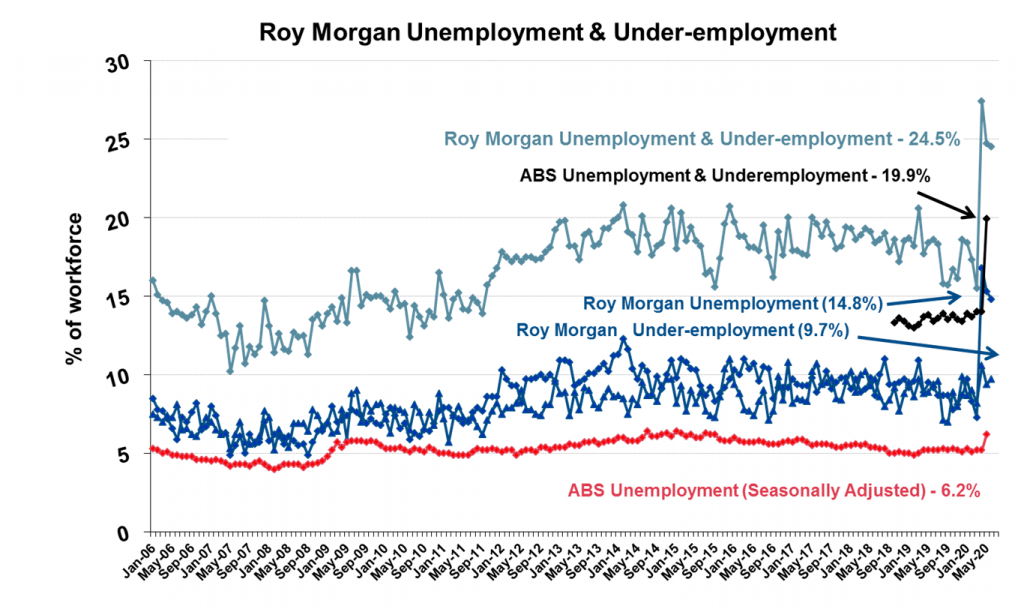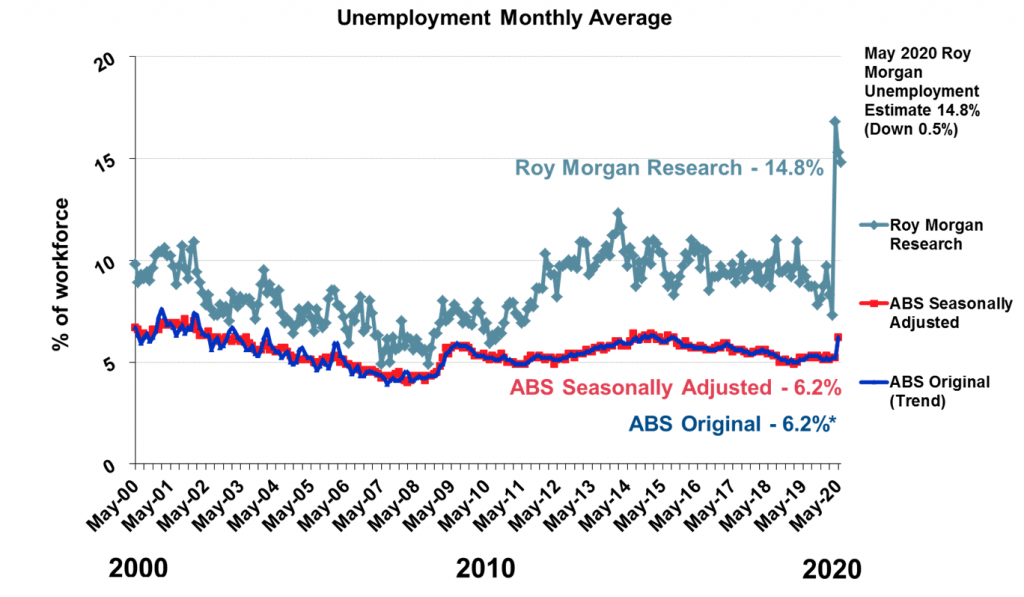2.09 million Australians unemployed in May, down 69,000 on April

In May 14.8% of the workforce (2.09 million Australians) were unemployed. This is down 69,000 on April as Australia begins to open up according to the latest Roy Morgan employment estimates.
An additional 9.7% of the workforce (1.37 million) was under-employed, up 44,000. This means a massive 3.46 million Australians (24.5%) are either unemployed or under-employed, down 25,000.
The decline in unemployment is good news as the Australian economy opens up but also illustrates how far the economy needs to go to return to the state it was in pre-lockdown. Compared to early March, the last measure before lockdown, there are an additional 1.07 million Australians unemployed (+7.5% points).
Latest Roy Morgan employment series data for May shows:
- The workforce in May was 14,128,000 – comprised of 12,038,000 employed and 2,090,000 unemployed Australians looking for work. The workforce total is down 22,000 since April;
- 12,038,000 Australians are employed in May, up 47,000 from April including 7,908,000 employed full-time, up 82,000, and 4,130,000 employed part-time, down 35,000;
- 2,090,000 Australians are looking for work in May, down 69,000 from April, driven by a fall in the number looking for full-time work which fell 94,000 to 907,000. 1,183,000 are looking for part-time work, up 25,000;
- Roy Morgan’s unemployment figure of 14.8% for May is more than double the current ABS estimate for April 2020 of 6.2%. However, the ABS figure for April estimated a large decline in the size of the workforce which they said was down 490,000. If the ABS workforce estimate for April had matched that in March the ABS unemployment figure would have been 9.8% (1.35 million).
Roy Morgan Unemployment & Under-employment (2019-2020)

Source: Roy Morgan Single Source January 2019 – May 2020. Average monthly interviews 4,000.
Michele Levine, CEO Roy Morgan, says restrictions are now being eased around Australia however a quarter of the Australian workforce is now unemployed or under-employed - obviously an under-estimation as 3.5 million are currently subsidised on JobKeeper:

“Roy Morgan’s unemployment measure for May shows 2.09 million Australians were unemployed (14.8% of the workforce) with an additional 1.37 million (9.7%) under-employed.
“In total a massive 3.46 million (24.5%) Australians are now either unemployed or under-employed, down 25,000 since April. If this number continues to drop at the rate of 25,000 per month it will take over four years until September 2024 before it approaches the levels of early March 2020.
“The trend in May is in the right direction as the Australian economy opens up but compared to the labour market situation pre-lockdown an additional 1.3 million Australians are now unemployed or under-employed – and this is while the JobKeeper program is still running.
“Earlier this week Treasurer Josh Frydenberg accepted Australia had entered its first recession for three decades. For Australia to emerge from this recession quickly during the next few months businesses and unions must work together to forge sensible and equitable solutions that encourage employers to hire new workers.
“A special Roy Morgan SMS survey conducted this week showed the recent Federal Court decision to award extra entitlements to certain categories of casual employees will effect up to 794,000 Australian businesses. A quarter of businesses (567,000) say they will be deterred from hiring casual employees and over 1-in-20 businesses (123,000) say the decision will ‘force them to close’.
“These results show that if businesses and unions don’t work together to develop sensible and realistic industrial relations many hundreds of thousands of Australians that have been put out of work as a result of the ‘COVID-19 Financial Crisis’ (CFC) will struggle to find new jobs and risk becoming long-term unemployed.”

*Workforce includes those employed and those looking for work – the unemployed.
This Roy Morgan survey on Australia’s unemployment and ‘under-employed’* is based on weekly face-to-face interviews of 684,202 Australians aged 14 and over between January 2007 and May 2020, and includes 6,698 telephone and online interviews in May 2020. *The ‘under-employed’ are those people who are in part-time work or freelancers who are looking for more work.


For further information:
| Contact | Office | Mobile |
| Gary Morgan: | +61 3 9224 5213 | +61 411 129 094 |
| Michele Levine: | +61 3 9224 5215 | +61 411 129 093 |
Unemployment Data Tables
ROY MORGAN MEASURES REAL UNEMPLOYMENT IN AUSTRALIA
NOT THE ‘PERCEPTION’ OF UNEMPLOYMENT – JUNE 8, 2012
The Roy Morgan Unemployment estimate is obtained by surveying an Australia-wide cross section by face-to-face interviews. A person is classified as unemployed if they are looking for work, no matter when. The results are not seasonally adjusted and provide an accurate measure of monthly unemployment estimates in Australia.
The Australian Bureau of Statistics Unemployment estimates are obtained by mostly telephone interviews. Households selected for the ABS Survey are interviewed each month for eight months, with one-eighth of the sample being replaced each month. The first interview is conducted face-to-face. Subsequent interviews are then conducted by telephone.
The ABS classifies a person as unemployed if, when surveyed, they have been actively looking for work in the four weeks up to the end of the reference week and if they were available for work in the reference week.
The ABS classifies a person as employed if, when surveyed, a person worked for one hour or more during the reference week for pay, profit, commission or payment in kind, or even if a person worked for one hour or more without pay in a family business or on a farm.
The Australian Bureau of Statistics Unemployment estimates are also seasonally adjusted.
For these reasons the Australian Bureau of Statistics Unemployment estimates are different from the Roy Morgan Unemployment estimate. Gary Morgan's concerns regarding the ABS Unemployment estimate is clearly outlined in his letter to the Australian Financial Review, which was not published.
For comments or more information please contact:
Roy Morgan - Enquiries
Office: +61 (03) 9224 5309
askroymorgan@roymorgan.com
Margin of Error
The margin of error to be allowed for in any estimate depends mainly on the number of interviews on which it is based. Margin of error gives indications of the likely range within which estimates would be 95% likely to fall, expressed as the number of percentage points above or below the actual estimate. Allowance for design effects (such as stratification and weighting) should be made as appropriate.
| Sample Size | Percentage Estimate |
| 40% – 60% | 25% or 75% | 10% or 90% | 5% or 95% | |
| 1,000 | ±3.0 | ±2.7 | ±1.9 | ±1.3 |
| 5,000 | ±1.4 | ±1.2 | ±0.8 | ±0.6 |
| 7,500 | ±1.1 | ±1.0 | ±0.7 | ±0.5 |
| 10,000 | ±1.0 | ±0.9 | ±0.6 | ±0.4 |
| 20,000 | ±0.7 | ±0.6 | ±0.4 | ±0.3 |
| 50,000 | ±0.4 | ±0.4 | ±0.3 | ±0.2 |
